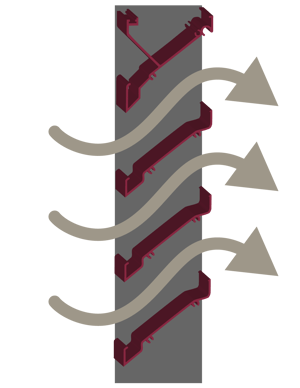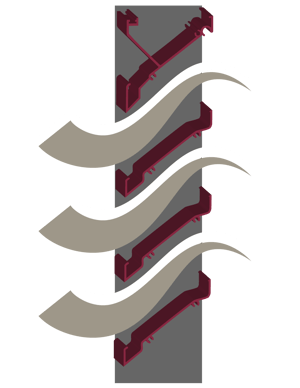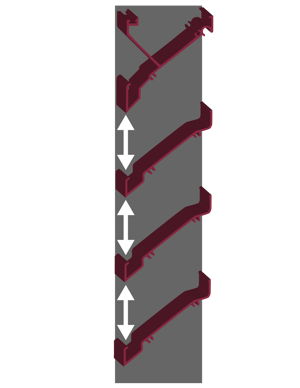An efficient HVAC system starts with louvers built for the task. Learn the three key factors to consider when choosing a louver for air performance.
Louvers in Sustainable Building
A green, sustainable building is many things: efficient spaces, built with renewable materials, provides a comfortable atmosphere for its occupants, and uses the least amount of resources and materials possible. An efficient HVAC system can go a long way towards making an sustainable building work.
And the most efficient HVAC systems start with louvers built for the task.
For more on louvers, read these Newsstand articles:
- Louver Blades - A Primer
- Anatomy of a Submittal
- Louvers by the Numbers
- The Condenser - Product Spotlight: The EA-531-D Series
Efficient Louvers - The Entrance and Exit of HVAC
Louvers designed for air performance can make the difference between an overtaxed system that wastes energy and an efficient system that saves you money over time. Let’s look at the first and last stage of every large-scale HVAC system: the intake and exhaust louvers on your building’s face.
 Louvers act as the entrance and the exit of your duct work, by covering the intake and exhaust openings of your HVAC system. For intake applications, a fan will draw air through the louver and into the HVAC system.
Louvers act as the entrance and the exit of your duct work, by covering the intake and exhaust openings of your HVAC system. For intake applications, a fan will draw air through the louver and into the HVAC system.
As air moves, it must go through the spaces between the louver’s blades. The louver's blades allow air in and prevent foreign material – water, sand, dust, and other debris – from getting through to the duct work beyond. Different louvers will perform these two functions in different ways, even though they may look the same.
Exhaust applications work in reverse: the fan pushes air through the louver to the outside. The same concepts will apply.
It’s important to find a balance between these two functions. Your louvers may be required to block a certain amount of water, to withstand hurricane-force winds, or to withstand wind-borne debris. If efficiency is your primary goal, then it is important to focus on the airflow aspect of the louver.
Pressure Drop - A Drag on Performance
There are three things to consider when choosing a louver for air flow: the louver’s blade profile, the louver’s free area, and the louver’s pressure drop. Blade profile refers to the surface features of the louver’s blades.

These features play a key role in blocking unwanted elements, but they can also cause air resistance. As air passes over the blade profile, its features will catch the unwanted elements in the air stream before they enter through the louver. This air resistance, known as pressure drop, represents the amount of air pressure lost as air moves from the face of the louver to the ductwork. Pressure drop will increase as air velocity across the louver’s face increases or if the amount of louver free area decreases.
The more obstructions that are in the airflow's way, the greater the loss in air pressure. If the louver has a high pressure drop, then intake fans will have to work harder to pull the amount of airflow through the louver. Your entire system will feel excess strain.
The key to efficiency is finding a balance between the louver's pressure drop and its ability to block rainwater. We cover air performance in this quick Condenser article.
Blade Profiles - Straight and Chevron
 For system efficiency, consider a louver with a simple blade profile: either flat or with very few features. Straight blades, also known as J-blades, is a standard louver blade with a flat surface. Straight blades are best suited for ventilation. These blades have no features or catches, but the angle of the blade can still serve as light protection from foreign elements.
For system efficiency, consider a louver with a simple blade profile: either flat or with very few features. Straight blades, also known as J-blades, is a standard louver blade with a flat surface. Straight blades are best suited for ventilation. These blades have no features or catches, but the angle of the blade can still serve as light protection from foreign elements.
The shape of Chevron blades is like an upside-down V. The middle section of the blade curves upward, creating a hill shape profile. As air enters the louver, it will move up the hill on the face side of the blade and then down the hill. This shape creates a natural flow that can block debris without sacrificing airflow.

Chevron blades often come with catches along the blade’s profile to capture moisture and smaller debris. The chevron blade is a delicate balance between water protection and air performance.
If efficiency is your primary concern, then your best option is a louver with straight blades.
Free Area - Space for Air Flow

The third factor – and the most important – to consider is free area. Free area refers to the amount of space between the louver’s blades. This measurement considers the catches and features of the louver's blade profile. Manufacturers express free area in square feet of the total free space between blades or as a percentage of the louver's total area.
Larger louvers will have more square feet of free area than a smaller louver, but the percentage of total louver area will be the same across all sizes. A louver with more free area will have less pressure drop than a louver with less free area, since there is more space for air flow.
When choosing a louver for air performance, look for a model that provides the most free area for the size you need. These louvers will provide the most airflow through the louver with minimal pressure drop, allowing for the most efficient airflow through your HVAC system.
By choosing air performance, you end up minimizing the amount of power needed to drive air through intake and exhaust louvers. This saves power and money over time! Learn more about the pressures involved in efficient airflow with "Balanced Flow".
Requirements Come First!
Your louvers will have more requirements than air performance. In areas with frequent severe weather, you may need a louver that can block wind driven rainfall. If your project is in a high velocity hurricane zone, your louver will need to resist hurricane-force winds, heavy rainfall, and wind-borne debris. In these cases, you may need to sacrifice air performance to meet these requirements. Your project’s requirements should always come first.
If you need a louver that provides efficient air flow, then consider a model with a high free area, low pressure drop, and a flat blade profile. These louvers will maximize airflow and increase efficiency in your HVAC system.
Every little bit counts when designing an efficient HVAC system. What do you look for when choosing a louver? What aspects stand out the most? Share your thoughts on louvers in the Comments section. We want to hear from you!

.webp?width=91&height=70&name=MCDLG%20Logo%20(Resize).webp)
.webp)




